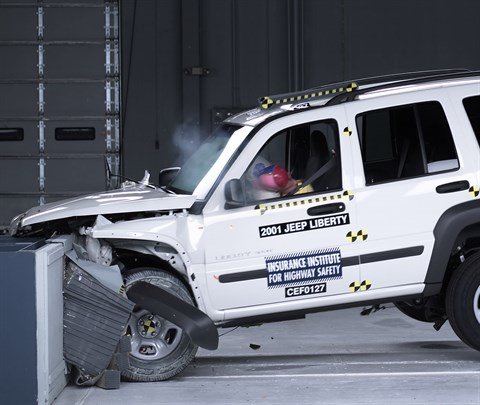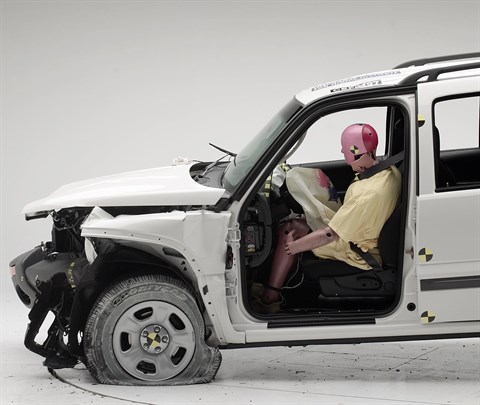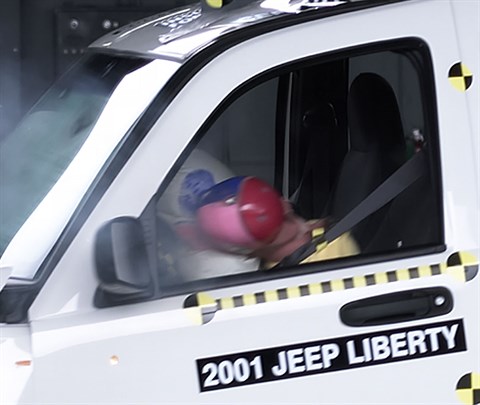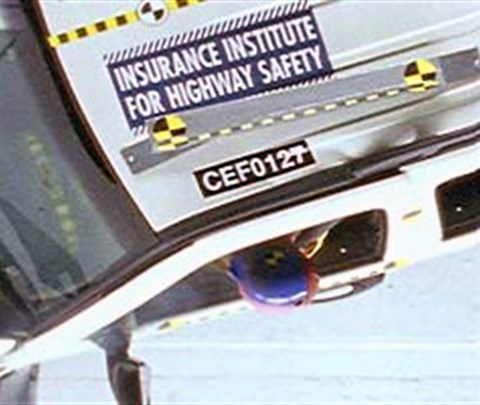Moderate overlap front: original test
Rating applies to 2002-07 models
Tested vehicle: 2002 Jeep Liberty Sport 4-door 4wd
The Jeep Liberty was introduced in the 2002 model year as a replacement for the Jeep Cherokee.
The Insurance Institute for Highway Safety has evaluated the crashworthiness of the Liberty in two 40 mph moderate overlap frontal crash tests into deformable barriers. In the first test, the airbag deployed late because an airbag sensor wire shorted out early in the crash. This led Chrysler to develop a fix for this problem by shielding the wiring, and the manufacturer recalled the affected vehicles. The Institute tested a second Liberty with the fix and the airbag inflated much earlier. Ratings of the Liberty are based on the results of the second test, except structural performance is based on both tests.
| Evaluation criteria | Rating |
|---|---|
| Overall evaluation | |
| Structure and safety cage | |
| Driver injury measures | |
| Head/neck | |
| Chest | |
| Leg/foot, left | |
| Leg/foot, right | |
| Driver restraints and dummy kinematics Dummy movement was reasonably well controlled in the second test. The dummy's head leaned out the open side window during rebound, then it hit the window frame. |
|

Action shot taken during the second of two frontal offset crash tests.

The driver's survival space was maintained well, as indicated by the dummy's position in relation to the steering wheel and instrument panel after the second crash test.

Forces on the head when the dummy moved into the airbag were moderately high in the second test, indicating the possibility of head injuries.

In both tests, the dummy's head moved outside the open side window after rebounding from the airbag (second test pictured).
Measures of occupant compartment intrusion on driver side
| Evaluation criteria | Measurement | |
|---|---|---|
| Test ID | CEF0122 | CEF0127 |
| Footwell intrusion | ||
| Footrest (cm) | 9 | 10 |
| Left (cm) | 7 | 8 |
| Center (cm) | 10 | 10 |
| Right (cm) | 3 | 3 |
| Brake pedal (cm) | 1 | 1 |
| Instrument panel rearward movement | ||
| Left (cm) | 0 | -1 |
| Right (cm) | 0 | 0 |
| Steering column movement | ||
| Upward (cm) | 1 | 3 |
| Rearward (cm) | 0 | -2 |
| A-pillar rearward movement (cm) | 1 | 1 |
Driver injury measures
| Evaluation criteria | Measurement | |
|---|---|---|
| Test ID | CEF0127 | |
| Head | ||
| HIC-15 | 772 | |
| Peak gs at hard contact | negligible | |
| Neck | ||
| Tension (kN) | 2.7 | |
| Extension bending moment (Nm) | 29 | |
| Maximum Nij | 0.51 | |
| Chest maximum compression (mm) | 36 | |
| Legs | ||
| Femur force - left (kN) | 3.2 | |
| Femur force - right (kN) | 2.8 | |
| Knee displacement - left (mm) | 11 | |
| Knee displacement - right (mm) | 8 | |
| Maximum tibia index - left | 0.91 | |
| Maximum tibia index - right | 0.66 | |
| Tibia axial force - left (kN) | 2.3 | |
| Tibia axial force - right (kN) | 2.2 | |
| Foot acceleration (g) | ||
| Left | 108 | |
| Right | 57 | |
Head restraints & seats
Seat type: Seats with fixed head restraints
| Overall evaluation | |
|---|---|
| Dynamic rating | |
| Seat/head restraint geometry |
| Seat type | Seats with fixed head restraints |
|---|---|
| Geometry | |
| Backset (mm) | 70 |
| Distance below top of head (mm) | 65 |
| Seat design parameters | |
| Pass/fail | Fail |
| Max T1 acceleration (g) | 12.5 |
| Head contact time (ms) | 96 |
| Force rating | 3 |
| Neck forces | |
| Max neck shear force (N) | 313 |
| Max neck tension (N) | 967 |
Seat type: Seats with adjustable head restraints
| Overall evaluation | |
|---|---|
| Dynamic rating | |
| Seat/head restraint geometry |
| Seat type | Seats with adjustable head restraints |
|---|---|
| Geometry | |
| Backset (mm) | 62 |
| Distance below top of head (mm) | 65 |
| Seat design parameters | |
| Pass/fail | Fail |
| Max T1 acceleration (g) | 12.1 |
| Head contact time (ms) | 94 |
| Force rating | 3 |
| Neck forces | |
| Max neck shear force (N) | 308 |
| Max neck tension (N) | 1,110 |
About the head restraint & seat test
Currently, IIHS tests apply only to front seats.
